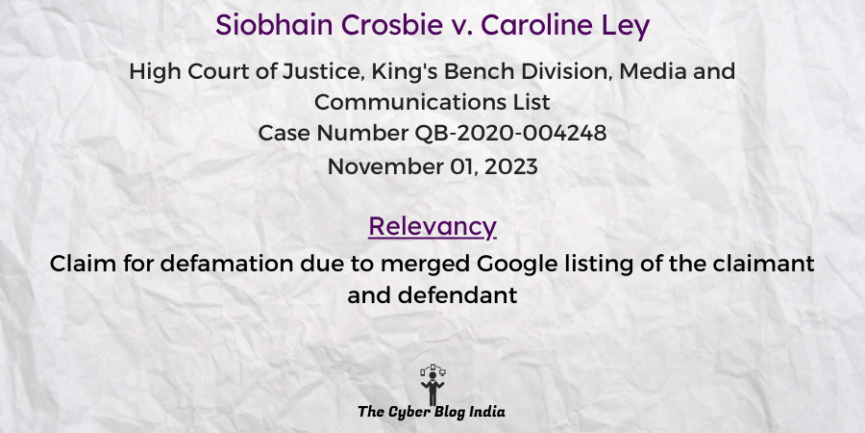Siobhain Crosbie v. Caroline Ley

Siobhain Crosbie v. Caroline Ley
[2023] EWHC 2626 (KB)
In the High Court of Justice, King’s Bench Division, Media and Communications List
Case Number QB-2020-004248
Before Justice Julian Knowles
Decided on November 01, 2023
Relevancy of the Case: Claim for defamation due to merged Google listing of the claimant and defendant
Statutes and Provisions Involved
- The Defamation Act 2013 (Section 2, 5, 8(3), 12)
- The Senior Courts Act 1981 (Section 35A)
- The Human Rights Act 1998 (Section 2, 3, 6, 12)
Relevant Facts of the Case
- The claimant has brought this defamation claim against the defendant, alleging that she misrepresented her business and caused financial harm.
- The defendant denies the allegations and counterclaims for defamation and harassment due to the claimant’s social media posts.
- Both the parties presented witness statements and testimonies. The claimant’s allegation states that phone calls intended for her were being diverted to the defendant’s mobile phone.
- The defendant disproved these allegations and sought to address the resulting harm due to false allegations.
- The defendant had also reported the claimant to the police for harassment. However, the police did not take any action.
- The claimant also accused the defendant of perpetrating criminal fraud for over five years.
Prominent Arguments by the Counsels
- The defendant’s counsel denied creating the business listings. The counsel claimed that Google’s software merged her BHCP listing with the claimant’s APS listing due to a bug or glitch. This resulted in a merged business listing showing details from both original listings. The defendant was unaware of this until the claimant contacted her in March 2016. She subsequently deleted the merged listing. The issue with the listing was not the defendant’s responsibility.
- Moreover, she did not intend to pass off her business as that of the claimant. Furthermore, the claimant’s social media posts on Facebook and Twitter accused her of fraud and dishonesty. These posts were false and damaging.
- The claimant’s counsel submitted that the defendant used the claimant’s trading style and web address for APS and the premise’s postcode. The call button directed a user to the defendant’s phone number. The defendant created an online directory entry using the claimant’s trading style. These actions harmed her business and caused her financial loss.
Opinion of the Bench
- The claimant has failed to prove that the defendant made an actionable misrepresentation. The defendant was not responsible for the merged listing, which the available evidence points to as a software error.
- The claimant’s publication was likely to cause serious harm to the defendant’s reputation. Moreover, her allegations are also not true. Therefore, it was defamation.
- The claimant’s publications are over four years old. They directly targeted the defendant and had threats of violence. Therefore, they have harassed the defendant.
Final Decision
- The court dismissed the claimant’s claim, granted an injunction against her, and ordered her to pay the defendant £75,000 in compensation.
Aditi Mangesh Sawant, an undergraduate student at NMIMS Kirit P Mehta School of Law, Mumbai, Arnav Kaman, an undergraduate student at Rajiv Gandhi National University of Law, Punjab, Adyasha Sahoo, an undergraduate student at the Institute of Law, Nirma University Ahmedabad, and Ritesh Karale, an undergraduate student at Maharashtra National Law University, Mumbai, prepared this case summary during their internship with The Cyber Blog India in January/February 2024.
